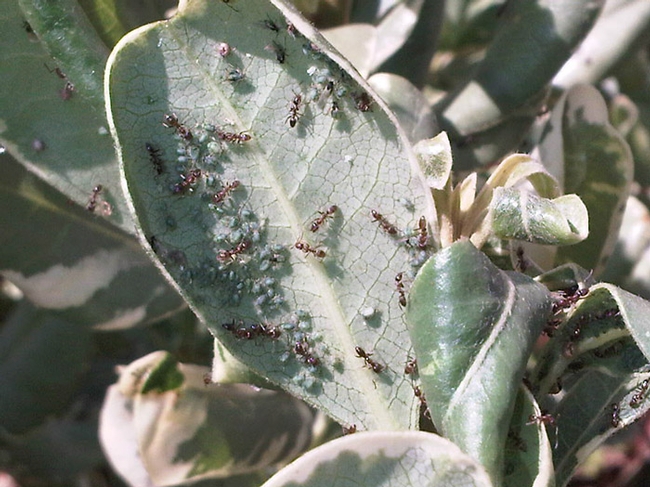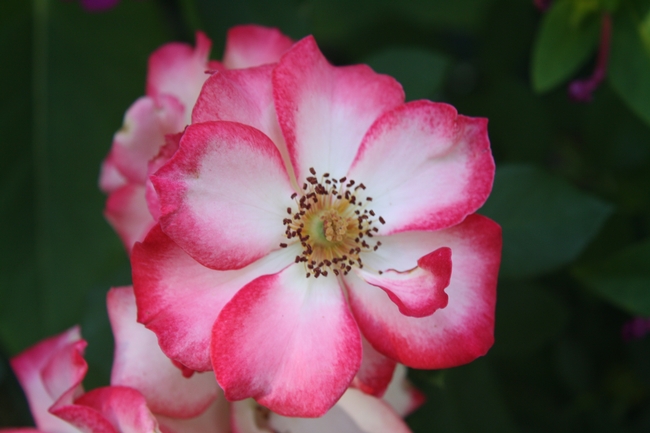- Author: Mary B. Gabbard
This past Saturday with the temperature hovering near 95 degrees, I was able to complete all my errands without breaking a sweat, thanks to a very effective air conditioner in my Honda CRV. Pulling into my my driveway, I was reminded by my wilting garden, that a Honda air conditioner can only do so much. A quick check of my sprinklers revealed they weren’t working, and hadn’t been on all week. (So much for the 16 year old son as the gardener,... what do they say? “You get what you pay for...”) Anyways, what does this mean to a gardener, well, a full day of hand watering. I actually don’t mind this because it gives me a chance to see what’s going on in my garden, as well as providing some much needed “me” time. Today, as I sprayed my Hummingbird Sage (Salvia spathacea), up popped a Praying Mantis! These are my favorite insects! They have triangular-shaped heads with a compound eye on each side.

The Praying Mantis is the only insect that can turn their head a full 180 degrees. They are named for their front legs, which are bent and held together as if they are praying.
The one I saw today, was brown, although on other watering-days, (my sprinklers break a lot), I have seen beautiful green mantis. A mantis is considered a predator that will eat all kinds of insects, good and bad. Most unfortunate recipients of unwanted mantis attention are moths, crickets, grasshoppers and flies. I also search for the egg case of the Praying Mantis when I water. Females regularly lay hundreds of eggs in a small case that is typically attached to woody stems, tree branches, or as in my yard, under the eaves.

Very cool!
- Author: Riva Flexer
I’ve been walking past this Pittosporum tobira ‘Variegata’ for at least five years now. It’s in my ‘kitchen’ raised bed, which should have become a vegetable bed, but, lacking enough sun and requiring major soil amendment, became a place to put plants that I could see from the kitchen. The pittosporum made its way there under false pretences. It’s supposed to produce sweet-smelling white flowers, but its attractive branch structure and variegated leaves are more interesting.
I’ve been pruning it back periodically, because it is really too big for the space, but my husband likes its location (hence the pruning). A few weeks ago, in a vain search for possible flower buds, I noticed that the new growth had aphids. Not only aphids, but a full complement of ants. It didn’t surprise me, but it means I will have to take some action.
Usually when there are aphids on my roses (which, in Quebec only happens in the spring), I wipe them off or remove them with a blast of water from the hose. If I feel it’s necessary, I’ll use some insecticidal soap solution, but that is rare. Of course, in California it seems as though it’s always spring, and pruning stimulates new growth. If you prune and fertilize, you’ll get lots of fresh, leggy, sweet-tasting new shoots.

So, the ants followed the honeydew trail, and they are "farming" the aphids for their that substance. They protect aphids from predators, like any good farmer, ants protect a food source, and they eat the aphid excrement. Now I have a dual problem. I’ll let you know what I do to solve it!
- Author: Betsy Lunde
Thoughts while pruning roses against the fence:
I'm trying to remember why on Earth I ever planted these roses on this side fence. Here I stand, attempting to dead-head, removing the last flush of bloom this one rose (actually large green rose hips) and trying to think of a good reason to sacrifice my flesh in the pursuit of ornamental horticulture. Was it the promise of large, silvery white blossoms glistening in the sun after a dark during a dismal rainy winter? Or was it the promise of bragging about the sheer mass of dark green leaves hidden among blossoms? Or did I just fall prey to flower catalog "madness "as I and others do each winter and early spring?
At this time, bloodied and with even more tears in a favorite gardening shirt -- all shirts seem to end up as marked for gardening after the first tears and stains-- I'm convinced that this large, overgrown rambler (Rosa 'Silver Moon') hates me to touch it! It's proud that it grew 20 feet this year -- again, and wants no loving sniping from me, just admiration for another year of blooming and growing! I know I'll heal again just as I have in the past. Darn that "prickle-bush" as Bruce calls it!! It knows as do the other rambling roses in my yard that I adore them and will continue to risk flesh and clothing to make them look their best. I'm trapped in my backyard and I can't stop sniping!

- Author: Marime Burton
Lasagna gardening? ‘Sounds crazy even when you know what that means. Crazier still, it’s a gardening technique that really works.
A little like diets that promise you’ll lose 20 pounds a month and never feel hungry, lasagna gardening sounds improbable, exaggerated and a waste of time. Better to stick with tried and true methods that reward hard work, sacrifice and the results of long-term commitment.
So I thought, but much like those diets I can’t resist, it sounded so simple I was willing give it a try.
First of all the old garden bed does not require tilling. Just cover weeds and all with a layer of cardboard or 3-5 layers of newspaper. Be sure to cover everything well to eliminate little peeks of sun nourishing future weeds. Soak the layers to keep them in place.
Voilà! Decomposition begins in the dark under those layers, earthworms begin to happily tunnel through the dark moist area and the soil begins to loosen up. The grass or weeds break down fairly quickly because they are in the dark under the paper.
Top off the lasagna with alternating layers of “browns” such as fall leaves, shredded newspaper, peat, and pine needles with layers of “greens” such as vegetable scraps, garden trimmings, and grass clippings, just as in a compost pile. Sprinkle it now and then.
Fall is the perfect time to start the process. Just leave it alone until spring, then start planting!
- Author: Sharon L. Rico
Several years ago, my husband and I cleaned out the 3' x 40' strip of soil between our house and our neighbors. There were several roses that were salvaged, but everything else was removed. This buffer zone between houses needed soil amendments, irrigation changes and plants that could handle hot afternoon sun. My husband wanted color and I wanted scent, so we compromised. He purchased two crape myrtles in red and plum and I went shopping for lavenders. Knowing that lavender is a Mediterranean plant, has few problems (root rot, mildew and rust), required little water and LOVED the hot afternoon sun, made it an ideal choice. The flowers would be harvested to use for decorating and smell, a real bonus. Many of the plants located at the nursery would grow too large for this narrow strip. Searching through the plant inventory at a local herb farm, Gros Bleu Lavender (Lavandula x intermedia) was found and it only grew to 13 inches. The plant marker also noted that it had extremely long flower heads and navy blue flowers. Eureka! My search was over and I have not been disappointed with my choice. They finished blooming last month and have been trimmed back to compact round orbs to keep them tidy and healthy, ready to fill out and scent our garden again next year!



